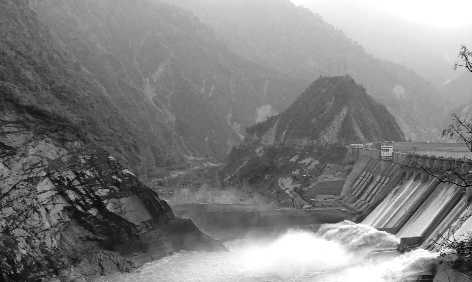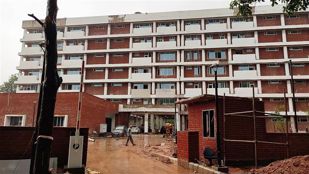
The Salal hydro-electric project in Reasi is managed by the NHPC. Photo: Inderjeet Singh
Sumit Hakhoo & Arteev Sharma in Jammu
- Last month, a woman died after an alleged mid-surgery power failure in the district hospital Shopian. The family alleged the woman had her vein ruptured during surgery conducted under flashlights of a mobile phone after a power failure.
- On June 2, last year, doctors were reportedly forced to carry out a crucial 40-minute surgery under torchlight at premier Government Medical College and Hospital (GMCH) Jammu after electricity went off and the power backup failed.
These and many more instances recur in a state that boasts of its hydro power potential of 20,000 MW (one megawatt can power-feed more than 200 families). The Chenab, Ravi and the Indus plus hundreds of rich, flowing streams gurgling around hills of the state are a poorly harnessed asset constricted by political compulsions and red-tape. The enormousness of these riches led state finance minister Haseeb Drabu to present a separate power budget along with the annual budget in the Assembly. The facts were out: J&K has a staggering Rs 7,000 crore power purchase liability this fiscal year. Its crippling effect only highlights the failures of successive government in reforming the power sector. As a result, the energy-deficient state relies on purchases from Northern Grid.
As per official figures, the state’s power revenue deficit in is Rs 3,927 crore. The gradual increase in recovery from consumers since 1996-97, from Rs 54.33 crore to Rs 1,937.27 crore (2015-16) is no match for the power purchase cost. A broad indicator of the operational inefficiency is the magnitude of AT&C (aggregate technical & commercial) losses: 59% in 2015-16, the highest in the country.
Unexplored potential
Out of the 20,000 MW potential, the government has identified about 16,697 MW. The reason for the gap is politics and corruption at various levels in completing several projects. Here are examples: the 850 MW Rattle project on Chenab in Kishtwar district was abandoned by the executing agency following a dispute with locals. There are several others awaiting the light of day: the Parnai project in Poonch, 1,200 MW Sawalkote, 600 MW Kiru, 240 MW Kirthal, 50 MW Lower Kainal, 520 MW Kawar and 280 MW Ujh.
There’s yet another glaring gap: 21 power projects operated by the state power development corporation don’t follow any standard operating manual necessary for energy accounting. In the face of such inefficiency, the state finance commission in 2011 and a working group headed by Dr C Rangrajan recommended that some projects run by the National Hydro Power Corporation (NHPC) should be handed to the state. The motive was clear: Why should NHPC pocket the revenue, why not the state? Two such demands were for the 390 MW Dulhasti and 1,020 MW Bursar project.
The government in 2013-14 got an audit conducted of projects on the Chenab, Ravi and the Indus basin generating 761.96 MW. It revealed that there are no laid-down procedures to grade the reliability of sophisticated meters installed to record the energy outflow, which tracks the generation of each unit. It was observed that no manual/standards are in place. As a result, there is no data recording in certain cases.
Reform measures
J&K’s special status has also come in the way of private investment. In 2011 the government announced a replacement of the State Hydel Policy, 2003. But it has failed to attract investment because of long bureaucratic procedures and red-tape. The National Conference-Congress coalition government in September 2012 ordered unbundling the power development department and setting up a transmission company, two distribution companies (one each for Kashmir and Jammu divisions) and a trading company. But it didn’t get off the ground following large-scale protests against privatization by PDD employees and the separatist lobby.



























